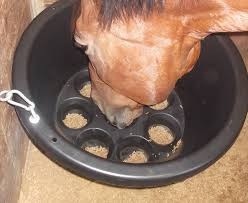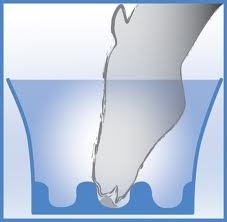Horse owners who hear of a condition called choke may instantly think of not being able to breathe and the Heimlich maneuver. However, choke in horses is a bit of a misnomer as it refers to an esophageal obstruction instead of a tracheal obstruction in humans. This blog will talk about why choke happens, how to recognize it, what you should do, and secondary complications.
Why do horses choke?
It most commonly occurs in horses consuming pelleted feeds, although it can also happen in horses consuming hay, beet pulp, and large horse treats. Horses continually produce saliva which can cause feeds to expand and block the esophagus. Abnormal chewing due to dental disorders or irregular teeth floating as well as bolting feed (eating large bites too fast) can cause the horse to have a larger than normal food bolus in the esophagus. Also, horses that eat too soon after being sedated may not swallow appropriately and can choke.

What to look for
The first thing owners usually notice is the horse’s inability to eat or drink as feed and saliva may be running out of their nostrils and mouth. They may also extend their head and neck due to discomfort. If the obstruction is large enough, you may even be able to see it (remember, the esophagus runs down the left side of a horse’s neck).
What do I do?
The very first thing to do is call your veterinarian. Although choke is rarely an immediately life threatening condition, it does require attention as soon as possible. Sedation may allow the horse to relax enough to pass the obstruction on its own. If not, the veterinarian will sedate the horse and pass a nasogastric tube through which water will be passed to break down the obstruction. It can be quite a messy process as everything will come out back through the nostrils and mouth. Further treatment usually includes anti-inflammatories like banamine and antibiotics.
Secondary complications
Early detection is the best way to minimize chances of complications. Aspiration pneumonia can occur when water and/or feed material enter the trachea and then lungs during the process. Signs usually develop 24 to 48 hours later and include a fever, coughing, or nasal discharge. Horses can also become dehydrated due to decreased water consumption both during the choke and afterward. Excessive salivation can cause acid-base imbalance due to electrolyte loss in the saliva. At the site of the esophageal obstruction, a stricture or diverticulum can form secondary to irritation.
Tips for preventing choke
1. Since pelleted feeds are commonly associated with choke, feeding a non pelleted feed may be needed. Or, wetting the feed is an easy alternative. This allows the pellets to expand before the horse ever eats it.
2. Feeding in a larger feed bin will allow the feed to spread out more and prevent them from taking such large bites.
3. Placing large river rocks or a salt block in their feed bin can also keep them from eating as quickly.
4. Pre-vent feeders can be used to slow down fast eaters and force them to take smaller bites. A picture of one is below.
5. Yearly dental exams are recommended to make sure that your horse is chewing appropriately and to ensure that they do not have any additional dental problems. Checking to see if your horse’s teeth need floating is a quick and free service that EVA offers. Please ask your veterinarian to do so the next time that your horse is seen for his yearly exam.

